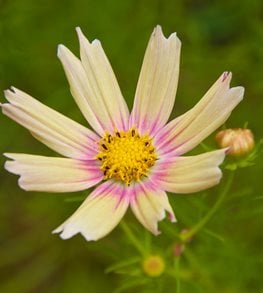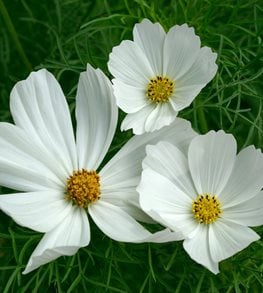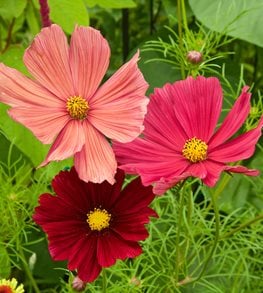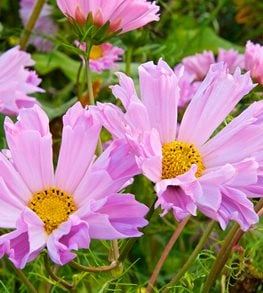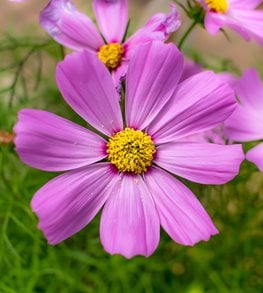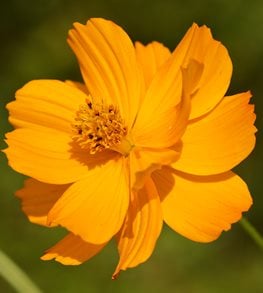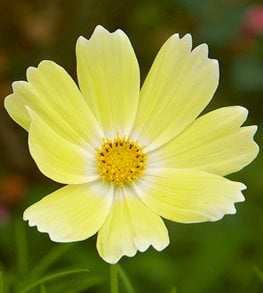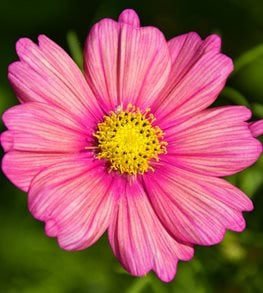Cosmos Flowers: A Growing Guide
Add this charming cottage garden favorite to your yard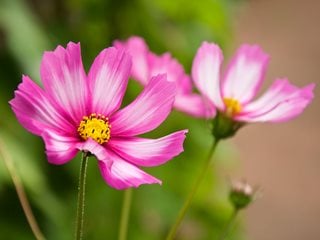
'Candy Stripe' cosmos flower. Photo by: Janet Loughrey
Cosmos is a flowering warm-season annual commonly grown from seed. A staple of cottage-style borders, cosmos produce cheerful daisy-like flowers from summer into fall. Even beginner gardeners will enjoy success with this easy to grow flower.
Though individual flowers last just several days, the buds are produced in clusters along the stems for long-lasting color in beds, borders, containers, or cut flower arrangements. Here’s how to grow and use cosmos plants in your yard.
On this page: Basics | Types | Planting | Care | Pictures | Using in the Garden | Frequently Asked Questions
On this page:
- BASICS
- HOW TO PLANT COSMOS FLOWERS
- COSMOS PLANT CARE
- POPULAR COSMOS VARIETIES
- USING COSMOS FLOWERS IN THE GARDEN
BASICS
Botanical name:
Cosmos spp.
Plant type:
Cosmos is a warm season annual that is grown from seed or starts. Chocolate cosmos is a tender perennial grown from tubers or seed.
Zone:
Most cosmos are annual in all zones. Chocolate cosmos is a tender perennial hardy in USDA zones 7-11.
Exposure:
Full sun
Bloom time:
Summer until frost
Growth habit:
Upright or mounding branching habit
Height/spread:
1 to 5 feet tall, 1 to 3 feet wide
Foliage:
Green foliage can be ferny, deeply dissected, or lance-shaped, depending on the species.
Flowers:
Daisy-like flowers 2 to 5 inches wide have single, double, semi-double, or fluted petals encircling a yellow or brown center. The blooms occur in colors of white, pink, magenta, burgundy, yellow, orange, apricot, or chocolate, with some bicolored or multi-colored. Petals can be rounded, ruffled, or fringed.
Benefits and other attributes:
Cosmos flowers are attractive to butterflies and other insect pollinators, while the seed heads are a food source for songbirds and other wildlife. Cosmos may reseed themselves in the next growing season, though some hybrids may not come true from seed.
Are cosmos plants poisonous?
Cosmos are not toxic to pets or children, though the ingestion of any ornamental plant may cause mild discomfort.
Are cosmos plants deer resistant?
Cosmos are resistant to deer browse, though it’s possible to incur some damage if other food sources are scarce.
HOW TO PLANT COSMOS FLOWERS

Photo by Dean Clarke / Shutterstock.
Cosmos can be planted from seed, tubers, or nursery-grown starts. A much broader selection of garden cosmos is available when growing plants from seed.
Where to plant:
Plant cosmos in a site with average well-draining soil that receives at least 6 to 8 hours of full sun.
When to plant:
Sow seeds indoors 4 to 6 weeks before your last average frost date. Direct sow seeds outdoors when all danger of frost has passed.
Soil:
Cosmos are tolerant of a range of soil conditions, but will perform best in average soil with good drainage and a pH of 6.0 to 8.0. Avoid planting in rich soil, which can cause plants to become leggy or fall over.
How to plant:
- Indoors: For indoor sowing, plant in trays using seed starting mix. Seeds germinate best in temperatures of at least 70 degrees F. Cosmos need lots of light from a bright sunny window or grow lights to prevent seedlings from becoming leggy. Thin to one seedling per cell. When all danger of frost is past, gradually acclimate plants to outdoor temperatures before transplanting to their final place in the garden.
- Outdoors: To direct sow outdoors, loosen soil in the planting area and make sure there is good drainage. Scatter seeds lightly and cover with 1/8-1/4 inch of fine soil. Keep the planting area evenly moist until seeds germinate in 7 to 21 days. When young seedlings reach several inches tall, thin to 12 to 18 inches apart. Resow in several weeks if desired to extend bloom time.
- From starts: For nursery starts, loosen soil in the planting area and amend as needed. Dig a hole slightly wider and shallower than the root ball. Remove plant from the container and gently tease out roots if potbound. Place in the hole so the top of the root ball is level with the surrounding soil. Fill in the hole with soil, tamp down gently to remove air pockets, and water thoroughly. Water regularly until established.
COSMOS CARE
Watering:
Cosmos are drought tolerant once established. Water once a week or more often during heat spells. For containers, water when the top 2 inches of soil feels dry. Avoid over-watering and overhead watering, which can lead to fungal disease or other problems.
Amendments and fertilizer:
Cosmos need little or no supplemental fertilizer. Soil that is too high in nutrients can cause plants to produce more foliage at the expense of flowers.
Pruning and deadheading:
Young plants can be pinched to encourage more branching, which will result in a bushier habit and more blooms. Wait until seedlings are 8 to 12 inches tall and snip the top several inches of the main stem to just above a set of leaves. Deadhead spent cosmos flowers regularly to encourage more blooms. After most of the flowers have faded, cosmos plants can be sheared back by up to a third of their size to stimulate new growth and flowers.
Support:
Taller plants may need staking or other support so they don’t fall over.
Pests:
When given the right growing conditions, cosmos are resistant to most pests and diseases. Pests can include aphids, Japanese beetles, leafhoppers, spider mites and thrips. Young seedlings may be prone to slug or snail damage.
Diseases:
Diseases, which are mostly due to overwatering or poor air circulation, can include aster yellows, bacterial wilt, botrytis, curly top virus, fusarium wilt, powdery mildew, and white smut.
POPULAR COSMOS VARIETIES
USING COSMOS PLANTS IN THE GARDEN

Photo by Gardens by Design / Shutterstock.
There are many ways to use cosmos in your landscape. Here’s how:
For borders and landscapes: Taller varieties can be used as a background plant, while shorter cosmos can be used as edging or in mass plantings.
For slopes and hillsides: Broadcast seed along a slope or hillside for long-lasting color.
For containers: Plant compact varieties in containers by themselves or in combination with other warm-season annuals with similar growing needs.
- Plant cosmos in a cottage-style border alongside other quintessential cottage plants such as allium, bee balm, coreopsis, delphinium, foxglove, hollyhock, lavender, and phlox.
- Include cosmos in a butterfly-friendly garden with other flowering plants such as pentas, lantana, salvia, sunflower, ageratum, and marigolds.
- Use cosmos in between other plants in a mixed border to fill in gaps for quick color.
- Create a cutting flower garden and include cosmos with other cut flowers such as dahlias, gladiolus, pinks, roses, snapdragons, sunflowers, and zinnias.
- Sprinkle cosmos seeds in a meadow garden to augment plantings of black-eyed Susan, blanket flower, blazing star, coreopsis, goldenrod, purple coneflower, and Shasta daisy.
- Edge a border or pathway with a shorter cosmos variety for weeks of continuous color.
- Sow cosmos seeds along with other quick-sowing annuals such as bachelor buttons, calendula, daisies, flax, four o’clock, poppies, and zinnias to brighten up a slope.
- Plant a shorter cosmos variety in a container by itself or in combination with other warm-season annuals such as coleus, lobelia, calibrachoa, marigold, or petunia.
- Plant tall cosmos along a fence or wall as a background element.
RELATED:
Annual Flowers
Cottage Garden Design Ideas
How to Make a Butterfly Garden
